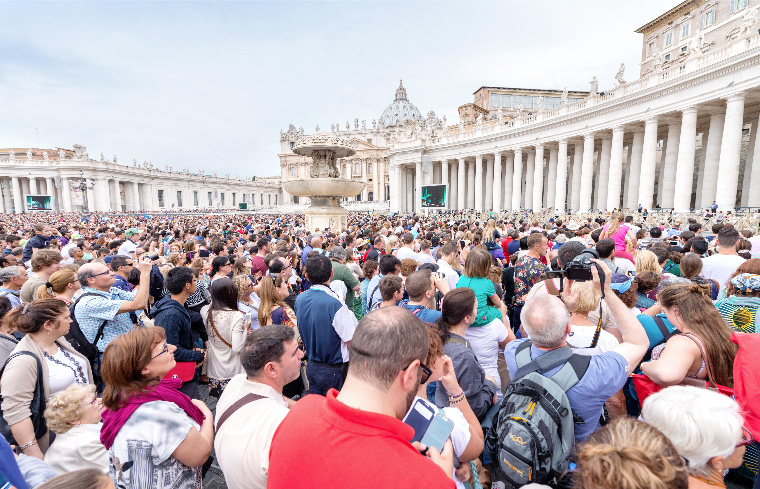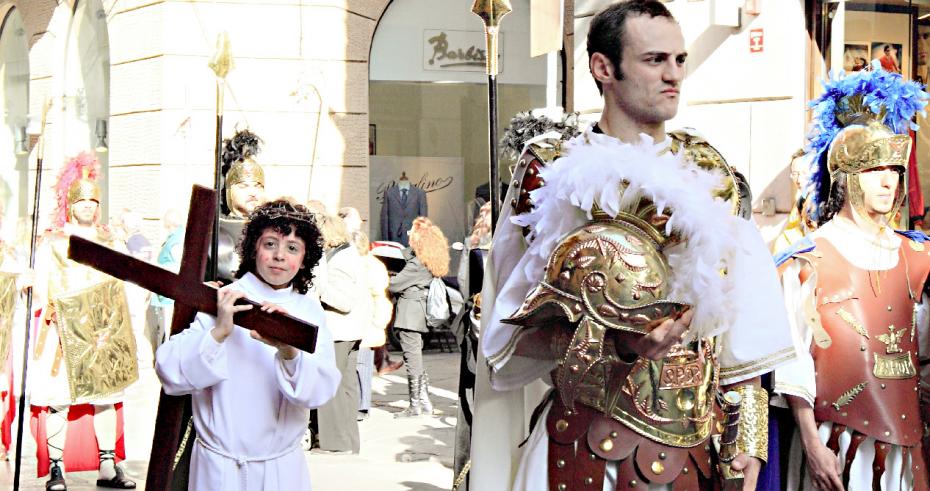On my first Easter in Rome in the Jubilee year of 2000, I joined the throngs jammed into the massive piazza of St. Peter’s basilica. Pope John Paul II, bent with age, extended Easter greetings in dozens of languages, including Italian. “Buona Pasqua!” the Roman family next to me shouted in return.
Just beginning my Italian studies, I traced the roots of Pasqua back to 1342, when it appeared in a reference to the feast commemorating the Jews’ liberation from Egyptian slavery. Lamb or “paschal” blood marked the doors of Hebrew families exiled in Egypt and spared their first-born sons. Somewhere in time Pasqua became synonymous with the Christian celebration of Easter.
During Holy Week (la Settimana Santa), I also learned the Italian names of the days my Catholic family had long celebrated. On la Domenica delle Palme (Palm Sunday), I waved a cross made of palm fronds and joined in the chorus of “Osannas.”
On Giovedì Santo (Holy Thursday) at la Messa dell’Ultima Cena (the Mass of the Last Supper), I watched as a pastor, in a gesture of humility, recreated Christ’s bathing of the feet of the Apostles by washing the feet of twelve parishioners.

After the service, the streets of Rome were strangely silent. Church bells would not ring until the Easter vigil Mass on Holy Saturday. A friend recalled her parents explaining that during this somber time, “Tutte le campane volano a Roma.” (All the bells are flying to Rome.)
Some villages in Italy stage dramatic processions or re-creations of le Stazioni della Via Crucis (the Stations of the Cross) on Venerdì Santo (Good Friday). In Enna in Sicily, more than 2,000 friars dressed in ancient costumes march through the streets. Italy’s oldest procession, in Chieti in the Abruzzi, features 100 violinists playing Selecchi’s Miserere.
In Rome the Pope solemnly progresses through the Stages of the Cross in and around the torch-lit Colosseum. As thousands of worshipers clutch candles in the dark, professional actors read dramatic interpretations of the suffering of Christ and of his heartbroken mother — one of the most moving religious experiences I’ve ever had.
After sundown on Sabato Santo (Holy Saturday), the solemn Veglia pasquale (Easter vigil) begins with the lighting of il cero pasquale (the Easter candle), which represents the “Light of Christ” (la luce di Cristo), and the renewal of baptismal vows.
On Easter morning, sunrise services throughout Italy celebrate the joy of the resurrection of Christ. Then, with equal exuberance, Italians end forty days of fasting during Quaresima (Lent) with food — and friends. “Natale con i tuoi, Pasqua con chi vuoi” (Christmas with your family, Easter with whomever you want), according to a popular saying.
The traditional main dish for Easter dinner is agnello al forno (roasted baby lamb) or capretto (baby goat). Rome’s specialty is abbacchio, a suckling lamb no more than a month or so old. Because it has ingested only its mother’s milk, its meat is especially tender.
Italy’s favorite Easter dessert is a sweet, eggy, yeasted bread topped with sugared and sliced almonds. Commercial bakers shape it into a colomba (dove), the symbol of peace and renewal, but home bakers usually do an oval approximation.
In Italy uova di Pasqua (Easter eggs) come only in chocolate. In the 15th century nobles encased works of art in enormous candy confections. The very best modern eggs are handmade by a cioccolataio, an artisan of chocolate, who inserts a surprise supplied by the purchaser.
Inside a customized egg a lucky recipient may find jewelry, a watch, car keys—or an engagement ring. This in itself may explain why “felice come una Pasqua” (literally happy as an Easter) translates into “happy as can be.”
After the grand religious rituals and elaborate feasts of Easter Sunday, families enjoy a quiet lunedì dell’Angelo (Angel’s Monday) or Pasquetta, with a picnic in the countryside beyond the walls of their cities. “Pasqua di rinascita, Pasquetta di festa,” Italians say. “Easter for rebirth; Pasquetta for party.”
To all of you, Auguri di Buona Pasqua! (Best wishes for a happy Easter!)
FYI: If you’re staying at a hotel in Rome, the concierge may have tickets available for the Vatican’s Holy Week ceremonies. Here is a link https://www.vaticantour.com/papalaudience#easter-christmas-mass to the official Vatican site with instructions on how to request tickets for Easter Mass at St. Peter’s. The earlier you apply, the better.
Dianne Hales (www.diannehales.com) is the author of La Bella Lingua: My Love Affair with Italian, the World’s Most Enchanting Language (http://tinyurl.com/js7kyfj) and Mona Lisa: My Life Discovered (http://tinyurl.com/h9wywhy)































